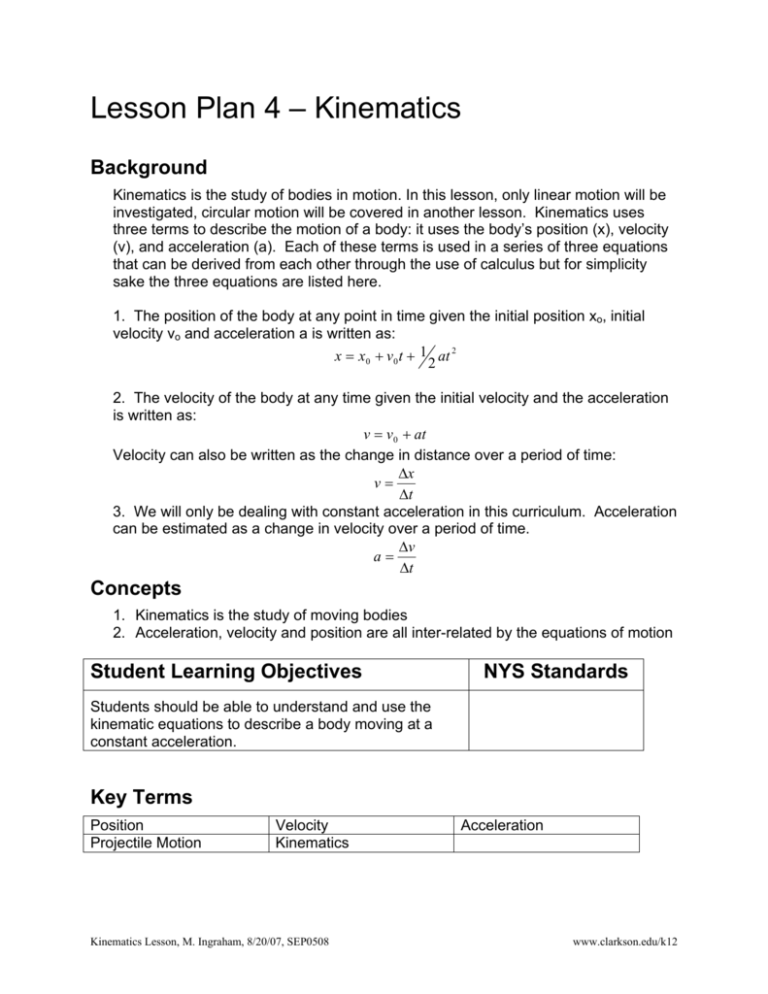Lesson Plan 4 – Kinematics
advertisement

Lesson Plan 4 – Kinematics Background Kinematics is the study of bodies in motion. In this lesson, only linear motion will be investigated, circular motion will be covered in another lesson. Kinematics uses three terms to describe the motion of a body: it uses the body’s position (x), velocity (v), and acceleration (a). Each of these terms is used in a series of three equations that can be derived from each other through the use of calculus but for simplicity sake the three equations are listed here. 1. The position of the body at any point in time given the initial position xo, initial velocity vo and acceleration a is written as: x = x0 + v 0 t + 1 at 2 2 2. The velocity of the body at any time given the initial velocity and the acceleration is written as: v = v 0 + at Velocity can also be written as the change in distance over a period of time: Δx v= Δt 3. We will only be dealing with constant acceleration in this curriculum. Acceleration can be estimated as a change in velocity over a period of time. Δv a= Δt Concepts 1. Kinematics is the study of moving bodies 2. Acceleration, velocity and position are all inter-related by the equations of motion Student Learning Objectives NYS Standards Students should be able to understand and use the kinematic equations to describe a body moving at a constant acceleration. Key Terms Position Projectile Motion Velocity Kinematics Kinematics Lesson, M. Ingraham, 8/20/07, SEP0508 Acceleration www.clarkson.edu/k12 Activities • • • • (5 mins) bring class to order and introduce the lesson to the students. Relate today’s lesson to roller coaster – view a portion of video shown in first lesson to observe acceleration and velocity. Try to draw general trend in velocity or position as a function of time. (Note – in these cases, acceleration not constant so it is hard to mathematically quantify with our tools (http://attraction.canadaswonderland.com/public/fun/videos.cfm )) Describe what they will be able to do by the end of the day – calculate velocity or position of an object as a function of time. (10 mins) Discuss conceptual relationship between position, velocity and acceleration. In general, if a body is accelerating, then overtime – velocity is increasing. This is a linear relationship X, v or a Position – increases in parabolic fashion with time (X α t2 ) Velocity – linear increase over time (v α t) Start at vo , slope of line = acceleration a vo xo Acceleration – constant over time Time • Write kinematic equations on the board and explaining each part of the equation and doing a practice problem with them. o Draw a picture – label known and unknown components and the forces acting on the body and their direction o Hint – look for clues in problem to help solve. For example “the body is at rest” at either the beginning or end – v=0 Motion in vertical direction – acceleration is due to gravity (a=g=9.8 m/s2) Kinematics Lesson, M. Ingraham, 8/20/07, SEP0508 www.clarkson.edu/k12 • (20 Mins) Have students work on Kinematic equations worksheet #1 and work through the problems, teachers will circulate and help students, students may work in pairs or alone on this part of the project. • (5mins) Wrap up lesson with what was covered, try to relate to video again. • Hand out kinematic equations HW (this is just an extension of the kinematic equations worksheet) Supply list Kinematic Equations worksheet Kinematic Equations HW Example Problems to put on the board, these can be made up by the instructor as they see fit. (Have fun with the examples you use) Resources Kinematic Equations Worksheet #1.doc Kinematic Equations HW#1.doc Kinematics Lesson, M. Ingraham, 8/20/07, SEP0508 www.clarkson.edu/k12 NAME: _________________________________________ Kinematic Equations Worksheet #1 1. John Doe gets on the highway in his 1967 Shelbey 427 Cobra. Starting from a dead stop at the bottom of the on-ramp it can be assumed that John accelerates at a rate of 6.7 m/s2. How long does it take for John to reach a speed of 30m/s? How far has John traveled in this time if you take his starting point to be 0m? 2. Baseball pitcher Josh Beckett throws a ball straight up in the air, the balls mass is 4kg, and he releases it at a speed of 35m/s, what is the maximum height that the ball will reach, and how long will it take for the ball to come back down and hit the ground next to him? Assume there is no air resistance, and the ball is released from and returns to a level of 0m. 3. Josh Beckett is now looking to throw a ball as far as he possibly can. So this time he is going to throw the ball away from himself at an angle of 45 degrees and at a velocity of 35 m/s. What is the highest point the ball reaches, and how far does the ball go if you assume that the ball is released from and comes to rest at a vertical height of 0m. Kinematics Lesson, M. Ingraham, 8/20/07, SEP0508 www.clarkson.edu/k12 NAME:_______________________________________ Kinematic Equations HW #1 1. John Doe gets off the highway in his 1967 Shelbey 427 Cobra. Starting from a speed of 35 m/s and decelerating at a rate of 7.4 m/s2 how long does the off ramp need to be for him to come to a dead stop? How long did it take him to come to a complete stop? 2. Baseball pitcher Tim Wakefield throws a 40 m/s fastball right down the center on a 3-2 count to strike out A. Rod. How long did it take for the ball to reach the batter if the pitcher’s mound is 18m away from home plate? Also, how far did the ball drop in that time from the height that Wakefield released it at? You can neglect air resistance. 3. During a hockey practice, Sabre’s player Brian Campbell fires a slapshot from the blue line towards goalie Ryan Miller. If the puck is moving at 50 m/s and the blue line is 19.3 m from the goal, what does Miller’s reaction time have to be to deflect the puck? You can neglect air resistance. Kinematics Lesson, M. Ingraham, 8/20/07, SEP0508 www.clarkson.edu/k12







